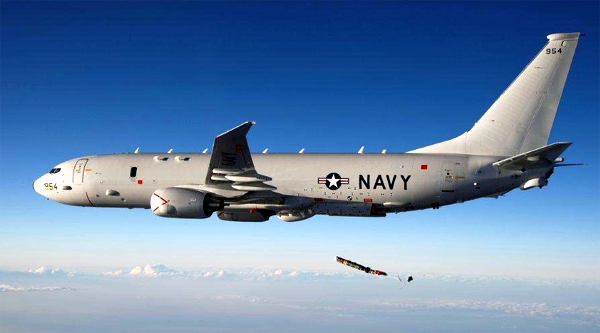|
A company spokesperson told India Strategic from
Tewksbury, US, that the US Navy has placed an
order for the torpedoes and associated equipment
worth US $ 45.3 millions for the Indian and Australian
navies. The breakup of numbers and respective
costs was not given,
The Indian Navy will deploy the missiles on
its eight P-8I long range maritime reconnaissance
aircraft being built and integrated by Boeing.
The torpedoes are primarily meant for hunting
submarines.
The aircraft will also carry Boeing’s Harpoon
Block II anti-ship missiles and other offensive
systems including the highly advanced Raytheon’s
APY-10 radar to track even small vessels far away.
Its range, though classified, should be between
300 to 400 km.
The aircraft being purchased by India and Australia
are the same, built on Boeing 737-800 platforms,
but the Indian variant has some systems supplied
by Indian companies to make its communications
secure and compatible with Indian naval and air
assets. They include Data Link II (communication
system) from Bharat Electronics, IFF (Identify
Friend or Foe system) transponder from HAL, speech
secrecy system from ECIL and mobile SATCOM (satellite
communication system) from Avantel.
India is buying eight P-8Is from Boeing and
its sophisticated EW (Electronic Warfare) and
missile systems are being acquired from the US
Navy under the US Government’s Foreign Military
Sales (FMS) programme.
A further order for another eight aircraft, and
possibly more later, is awaited as the Indian
Navy gradually has to phase out its outdated Soviet
vintage maritime aircraft within the coming few
years.
The first two aircraft are already under test
flights and should be delivered mid 2013, Boeing
officials had told a group of visiting Indian
journalists in July.
The impending torpedo deal was announced in
June this year by Pentagon’s Defense Security
Cooperation Agency (DSCA), which manages the FMS.
It had said then: "This sale reflects the
mutual benefits of the U.S.-India security partnership.
For India, the combined sale of the P-8I aircraft
with the Mk-54 torpedoes will add to India's anti-submarine
capability, as it expands its ability to protect
India and the critical sea lanes of the Indian
Ocean… The offer highlights the US commitment
to share cutting-edge technology with India and
to ensure that both nations enjoy the benefits
of a secure and stable South Asia."

The Indian variant also has an aft radar –
APS-143C(V)3 Multi-Mode Radar (MMR) – by
Telephonics to ensure 360 degree radar coverage
and a transponder beacon from DRS Technologies,
both US companies.
Raytheon officials told this writer during a
recent visit to the Rhode island, US, that the
MK54 is the US Navy’s next generation lightweight
torpedo, designed to counter the threats of enemy
submarines in deep-ocean or littoral environments.
“Developed jointly by Raytheon Integrated
Defense Systems and the U.S. Navy, the MK54 leverages
the most modern torpedo technologies from the
MK50 and MK48 ADCAP (advanced capability) programs
as well as the proven warhead and propulsion subsystems
of the MK46.”
“As enemy submarines remain a threat to
security, stability and access to the world’s
oceans, naval forces worldwide require a reliable
and effective undersea warfare weapon,” said
Kevin Peppe, vice president of Seapower Capability
Systems for Raytheon’s Integrated Defense
Systems business.
“Together with the U.S. Navy, we continue
to advance the development of the world’s
most effective lightweight torpedo, delivering
its proven capabilities to meet the anti-submarine
warfare needs” of US and friendly fleets.
The MK54 can also be deployed from a surface
ship, helicopter or fixed wing aircraft to track,
classify and attack underwater targets.
|